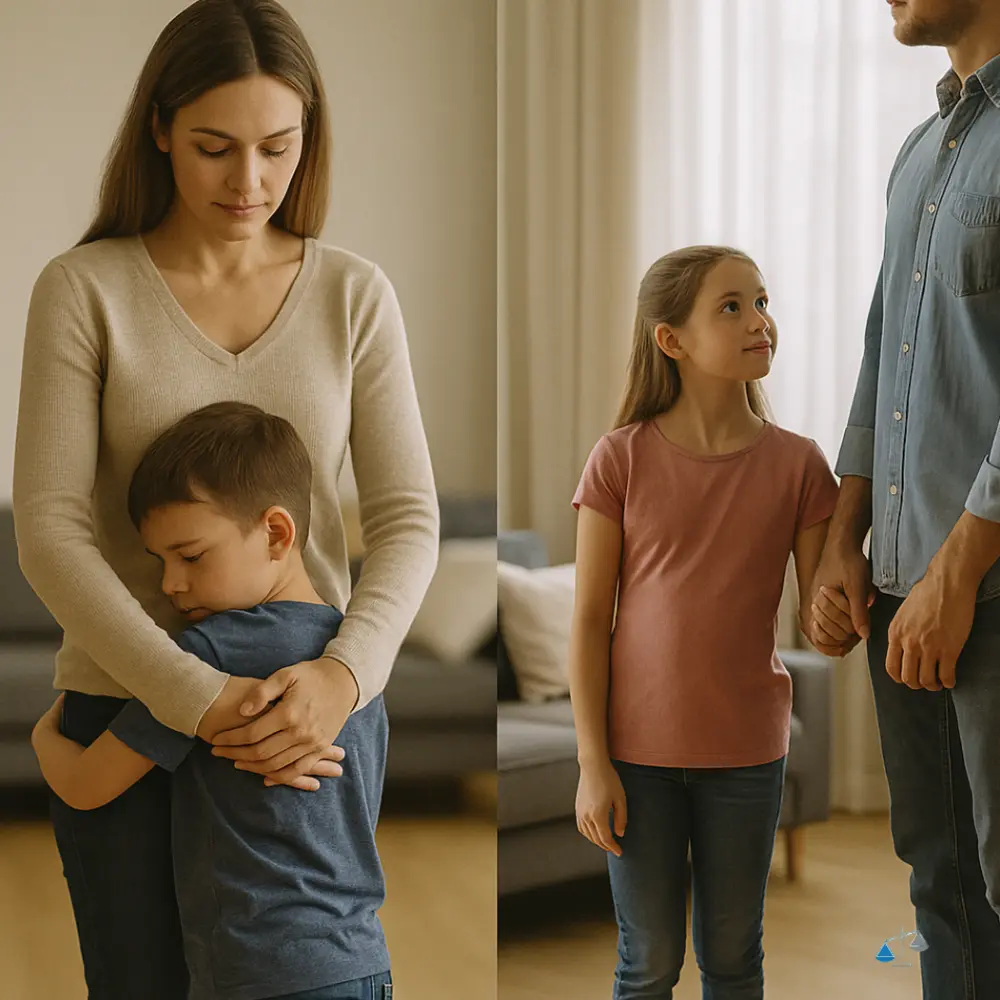Legal Custody vs Physical Custody: What’s the Difference?

When parents separate or divorce, one of the most important issues to resolve is the custody of their children. Custody determines not only where the child will live but also who has the authority to make critical decisions about the child’s upbringing. In U.S. family law, custody is generally divided into two categories: legal custody and physical custody. While they often overlap, they serve different purposes and carry distinct rights and responsibilities for parents. Understanding the difference is essential for protecting both parental rights and the best interests of the child.
What Is Legal Custody?
Legal custody refers to a parent’s right and responsibility to make important decisions about a child’s upbringing. Unlike physical custody, which focuses on where the child lives, legal custody is about decision-making authority. Courts recognize that children’s well-being depends not only on their daily care but also on thoughtful, long-term decisions that shape their lives.
Core Areas of Legal Custody
Parents with legal custody typically have the authority to decide on issues such as:
- Education – Choosing schools, special education programs, or tutoring services.
- Healthcare – Authorizing medical treatments, dental care, and psychological counseling.
- Religion – Deciding whether and how a child will participate in religious practices.
- Extracurricular activities – Approving participation in sports, clubs, and other activities that impact a child’s development.
Types of Legal Custody
- Sole Legal Custody: One parent has the exclusive right to make these decisions. The other parent may still have visitation rights but cannot influence major choices.
- Joint Legal Custody: Both parents share decision-making responsibilities. This requires ongoing cooperation and communication, even if the child primarily lives with one parent.
Practical Implications
Legal custody does not determine how much time a parent spends with the child on a daily basis. Instead, it governs the authority behind life-shaping decisions. For instance, a parent with joint legal custody cannot unilaterally transfer a child to another school without consulting the other parent. Similarly, a parent with sole legal custody has full control over such decisions without needing the other parent’s consent.
Example Scenario
Consider a divorced couple where the child lives mostly with the mother (primary physical custody). However, both parents share joint legal custody, meaning the father must be consulted when making choices about the child’s healthcare or education. This balance ensures that both parents remain actively involved in shaping the child’s future, even if daily routines are not equally shared.
What Is Physical Custody?
Physical custody determines where a child will live on a day-to-day basis and which parent is responsible for providing daily care. While legal custody centers on decision-making power, physical custody is about the child’s primary residence and routine living arrangements.
Types of Physical Custody
- Sole Physical Custody: The child primarily resides with one parent, while the other parent may be granted visitation rights or parenting time.
- Joint Physical Custody: The child splits time between both parents’ homes. This arrangement does not always mean an exact 50/50 split, but it requires both parents to have substantial time with the child.
- Primary vs. Secondary Custody: In joint arrangements, one parent is often designated the “primary custodian” to provide stability, while the other parent still enjoys regular visitation.
Factors Considered in Physical Custody
Courts generally prioritize the best interests of the child, which may include:
- Stability and continuity in living arrangements.
- The child’s relationship with each parent.
- School location and educational stability.
- The ability of each parent to provide for the child’s physical and emotional needs.
- The child’s age and, in some jurisdictions, their preferences.
Practical Implications
Physical custody shapes the child’s daily life—where they sleep, attend school, and spend weekends and holidays. For instance:
- If a parent has sole physical custody, the child lives with that parent most of the time, and the other parent may have visitation every other weekend.
- In a joint physical custody plan, the child might spend alternating weeks or split weekdays and weekends between both parents’ homes.
Example Scenario
Imagine two parents living in the same city after divorce. They agree to a joint physical custody schedule: the child lives with the father from Monday to Thursday and with the mother from Friday to Sunday. Even though both parents share physical custody, the arrangement is designed to balance stability (consistent school routine) with meaningful time spent with each parent.
In short, physical custody focuses on where the child lives and who provides daily care, while legal custody governs who makes the major decisions about the child’s upbringing.
Key Responsibilities Under Each Type of Custody
Both legal custody and physical custody carry unique sets of responsibilities for parents. Understanding these obligations helps clarify why courts often distinguish between the two when structuring custody arrangements.
Responsibilities in Legal Custody
Parents with legal custody are entrusted with shaping the long-term direction of their child’s life. This includes:
- Educational decisions: Selecting schools, monitoring academic progress, and approving specialized programs.
- Healthcare choices: Authorizing surgeries, therapies, or counseling.
- Religious upbringing: Deciding whether the child will be raised in a particular faith.
- Moral and developmental guidance: Approving extracurricular activities that affect the child’s growth.
A parent with sole legal custody bears this responsibility alone, while joint legal custody requires collaboration, communication, and often compromise between parents.
Responsibilities in Physical Custody
Physical custody revolves around the day-to-day care of the child. These responsibilities include:
- Providing food, clothing, and shelter.
- Overseeing homework, school attendance, and routines.
- Ensuring medical needs and daily health care are met.
- Supervising social activities, playtime, and discipline.
When physical custody is joint, parents must coordinate schedules to minimize disruptions in the child’s life. This often involves careful planning around school calendars, holidays, and extracurricular activities.
Overlap and Potential Conflicts
While legal and physical custody are distinct, they frequently overlap. For instance:
- A parent with physical custody during the week may need to consult the other parent (if joint legal custody exists) before authorizing a medical procedure.
- A parent with sole legal custody might decide on a new school, but if the school is located far away, it will directly impact physical custody schedules.
Example
Consider a case where the mother has sole physical custody, but both parents share joint legal custody. The father may not control daily routines like bedtime or meals, but he still has a voice in major choices such as healthcare and education. This ensures that even non-residential parents remain active in shaping the child’s future.
In short, legal custody focuses on decision-making authority, while physical custody emphasizes daily caregiving responsibilities. Both must work together to serve the child’s best interests.
Sole vs. Joint Custody Arrangements

Custody in family law is often categorized as either sole custody or joint custody, and this classification applies to both legal custody and physical custody. Understanding the distinctions between these arrangements is vital for parents navigating divorce or separation, as each setup directly affects both parental rights and a child’s daily life.
Sole Custody
- Sole Legal Custody: One parent has the exclusive right to make all major decisions regarding the child’s upbringing. The other parent may still have visitation but has no authority over education, healthcare, or religious choices.
- Sole Physical Custody: The child resides primarily with one parent, while the other may have visitation rights (sometimes supervised, depending on circumstances).
Sole custody is often awarded when:
- One parent is deemed unfit due to abuse, neglect, or substance abuse.
- Parents live too far apart to make joint arrangements practical.
- The child’s best interests require stability with one primary custodian.
Joint Custody
- Joint Legal Custody: Both parents share decision-making authority. Courts often prefer this arrangement, as it encourages continued involvement from both parents.
- Joint Physical Custody: The child spends significant time living with each parent, though the schedule may not always be equal (e.g., 60/40 or 70/30 splits).
Joint custody is favored when:
- Both parents are capable, willing, and cooperative.
- The parents live relatively close to one another.
- A shared arrangement aligns with the child’s best interests, offering stability and frequent contact with both parents.
Benefits and Challenges
- Benefits of Sole Custody: Clarity in decision-making, fewer conflicts, and consistent routines for the child.
- Challenges of Sole Custody: The noncustodial parent may feel excluded, and the child may miss out on balanced parental involvement.
- Benefits of Joint Custody: Promotes active involvement from both parents, strengthens bonds, and distributes responsibilities.
- Challenges of Joint Custody: Requires strong communication, logistical coordination, and may be disruptive if parents do not cooperate.
Example Scenario
Consider divorced parents living in the same city. The court grants joint legal custody, allowing both to decide on schooling and medical care. However, because the mother travels frequently for work, the father receives sole physical custody, ensuring the child has a stable home environment. This hybrid arrangement balances decision-making equality with practical caregiving stability.
Impact on Decision-Making and Parenting Time
The distinction between legal custody and physical custody has a direct impact on how decisions are made and how much time each parent spends with the child. Courts aim to create arrangements that balance parental rights with the child’s best interests, but the effects can vary significantly depending on whether custody is sole or joint.
Decision-Making Authority
- Legal Custody: Determines who has the power to make long-term decisions. In sole legal custody, only one parent has this authority. In joint legal custody, both parents must collaborate, which can sometimes lead to disagreements.
- Physical Custody: While primarily about daily care, it indirectly affects decision-making. For example, the parent with more physical custody often has more influence over everyday choices like diet, routines, and extracurricular activities.
Parenting Time
- Sole Physical Custody: The child lives mainly with one parent, and the other is granted scheduled visitation (weekends, holidays, or summer breaks).
- Joint Physical Custody: Both parents share significant time, but this doesn’t always mean a 50/50 split. Courts may order a flexible schedule depending on work commitments, school locations, and the child’s needs.
Practical Implications
- Conflict Potential: Joint legal custody requires cooperation. If parents have a history of conflict, decision-making can become challenging.
- Child Stability: Frequent transitions between homes under joint physical custody may cause disruption, while sole custody may offer more consistency but limit contact with one parent.
- Parental Involvement: A parent with limited physical custody may still remain deeply involved through joint legal custody, ensuring a voice in major decisions.
Example Scenario
Imagine a child who lives primarily with the father (sole physical custody), but both parents share joint legal custody. The mother cannot decide unilaterally to switch the child’s school, even though she doesn’t see the child daily. Conversely, the father, despite being the primary caregiver, must seek agreement for major health care or education decisions.
In essence, legal custody defines authority, while physical custody dictates time spent together. Both factors influence how parents interact with each other and with their child after separation.
Court Considerations in Custody Determinations
When deciding custody arrangements, courts focus on the best interests of the child. Judges evaluate a variety of factors to determine whether legal custody, physical custody, or a combination of both should be granted to one or both parents. These considerations are guided by state laws but generally include similar principles.
Key Factors Courts Evaluate
- Child’s best interests – The overarching standard, ensuring that custody decisions support the child’s well-being, stability, and development.
- Parental fitness – Courts assess each parent’s ability to provide a safe, nurturing environment, including emotional support and financial stability.
- Child’s relationship with each parent – Judges look at the strength of existing bonds, including the child’s emotional attachment to each parent.
- History of caregiving – The parent who has been the primary caregiver may be favored, as continuity is often seen as beneficial to the child.
- Geographic stability – Courts consider school location, community ties, and whether the child’s routine will be disrupted by relocation.
- Co-parenting ability – In joint custody cases, the ability of parents to communicate and cooperate plays a major role.
- Health and safety concerns – Evidence of abuse, neglect, or substance abuse can weigh heavily against a parent.
- Child’s preferences – Depending on age and maturity, some jurisdictions allow children to express their custody preferences.
Legal vs. Physical Custody in Court Decisions
- Legal Custody: Courts often lean toward joint legal custody, unless conflict or misconduct makes cooperation impossible.
- Physical Custody: Courts may grant sole physical custody if one parent provides more stability, or joint physical custody if both parents can offer balanced homes.
Example Consideration
Suppose both parents live within the same school district and have a history of effective co-parenting. A court might grant joint legal and joint physical custody to maintain stability and encourage ongoing parental involvement. Conversely, if one parent struggles with substance abuse, the court may award sole legal and physical custody to the other parent, while restricting visitation rights.
Why Court Oversight Matters
Custody arrangements can have long-term effects on a child’s emotional and educational development. Courts must carefully weigh all evidence to ensure the outcome promotes a child’s stability, security, and growth, rather than merely accommodating parental wishes.
Advantages and Challenges of Legal Custody vs Physical Custody
Both legal custody and physical custody play essential roles in post-divorce parenting, but each comes with unique benefits and difficulties. Understanding these can help parents set realistic expectations and prepare for potential challenges.
Advantages of Legal Custody
- Shared decision-making: In joint legal custody, both parents continue to influence major life choices, preserving a sense of involvement.
- Checks and balances: One parent cannot unilaterally make important decisions, reducing the risk of abuse of authority.
- Encourages cooperation: Joint legal custody fosters communication between parents, which can benefit the child’s emotional well-being.
Challenges of Legal Custody
- Conflict potential: Parents with different values or strained relationships may struggle to agree on education, religion, or medical treatments.
- Delays in decision-making: Requiring both parents’ consent can slow down urgent decisions.
- Court intervention: Persistent disputes may require returning to court, adding costs and stress.
Advantages of Physical Custody
- Stability in daily life: Sole physical custody can provide the child with a consistent home environment.
- Balanced parenting time: Joint physical custody allows the child to maintain close relationships with both parents.
- Flexibility: Custody schedules can be customized to match parents’ work commitments and the child’s school calendar.
Challenges of Physical Custody
- Logistical complications: Joint physical custody may involve frequent transitions between households, which can be disruptive.
- Unequal time distribution: Even in “joint” arrangements, one parent may end up spending significantly less time with the child.
- Emotional strain: A child may feel torn between parents or miss out on stability if arrangements are inconsistent.
Example Contrast
Consider a divorced couple with joint legal custody but sole physical custody awarded to the mother. The father has visitation every other weekend. While both parents share a voice in big decisions (legal custody), the mother carries most of the daily caregiving responsibilities (physical custody). This example highlights how custody arrangements can create different advantages and challenges for each parent.
In short, legal custody emphasizes shared responsibility for decision-making, while physical custody directly affects the child’s daily experiences and living environment. Both must be carefully structured to balance parental involvement with the child’s best interests.
Comparison Table: Legal Custody vs Physical Custody
The distinction between legal custody and physical custody can sometimes be confusing because both influence a child’s life in different ways. A side-by-side comparison makes the differences clearer.
Key Differences
| Aspect | Legal Custody | Physical Custody |
|---|---|---|
| Definition | Authority to make major decisions about the child’s life | Determines where the child lives and daily care arrangements |
| Focus | Education, healthcare, religion, and long-term planning | Residence, routines, and day-to-day caregiving |
| Types | Sole Legal Custody, Joint Legal Custody | Sole Physical Custody, Joint Physical Custody |
| Parental Role | Decision-maker for long-term issues | Daily caregiver responsible for housing, meals, supervision |
| Court Preference | Courts often favor joint legal custody | Depends on stability; may grant sole or joint physical custody |
| Impact on Parent | Determines voice in important decisions | Determines amount of parenting time and home environment |
| Revocability | Modifiable by court if disputes arise | Modifiable by court if circumstances change |
Practical Illustration
- Legal Custody Example: Parents share joint legal custody, so both must agree before changing the child’s school or approving surgery.
- Physical Custody Example: The child lives primarily with one parent (sole physical custody), while the other has visitation rights.
In short, legal custody answers “Who decides?”, while physical custody answers “Where does the child live?”.
Real-Life Examples of Custody Arrangements
Looking at real-life custody arrangements helps illustrate how courts apply the concepts of legal custody and physical custody in different family situations. These examples show the variety of outcomes depending on parental circumstances, cooperation levels, and the child’s best interests.
Example 1: Joint Legal, Sole Physical Custody
Sarah and Mark divorced after ten years of marriage. Their child, Emma, lives primarily with Sarah because her school and friends are nearby. Sarah has sole physical custody, but both parents share joint legal custody, meaning Mark still has an equal voice in education, healthcare, and religious decisions.
Example 2: Sole Legal and Sole Physical Custody
John has a history of substance abuse and inconsistent employment. After reviewing the evidence, the court grants his ex-wife, Lisa, both sole legal custody and sole physical custody of their son. John is given supervised visitation rights, but Lisa has complete authority over major decisions and daily caregiving.
Example 3: Joint Legal and Joint Physical Custody
David and Maria live in the same city and maintain a cooperative relationship post-divorce. The court awards them joint legal custody and joint physical custody. Their daughter spends alternating weeks at each parent’s home. Both parents collaborate on schooling and healthcare choices, ensuring equal involvement.
Example 4: Modified Joint Custody Due to Logistics
After separation, Robert and Anna initially received joint physical custody of their son. However, Robert’s new job required frequent travel, disrupting the arrangement. The court later modified the order to sole physical custody for Anna while retaining joint legal custody, so Robert still participates in major decisions but has less daily caregiving responsibility.
Example 5: Limited Legal Custody in High-Conflict Case
Karen and Tom frequently argue over their children’s schooling and medical treatments. To reduce conflict, the court awards sole legal custody to Karen while granting joint physical custody. This allows both parents to share time with the children but avoids constant disputes over long-term decision-making.
Lessons from These Examples
- Courts often favor joint legal custody to keep both parents involved in major decisions.
- Physical custody depends more on stability, logistics, and the child’s routine.
- Custody arrangements can be modified if circumstances change, such as relocation, health issues, or conflicts between parents.
FAQs About Legal Custody vs Physical Custody
What is the difference between legal custody and physical custody?
Legal custody refers to the right to make major life decisions for the child, while physical custody determines where the child lives and who provides daily care.
Can parents share both legal and physical custody?
Yes. Many courts encourage joint legal custody and, when practical, joint physical custody so both parents remain actively involved in their child’s life.
What happens if parents with joint legal custody disagree?
If parents cannot reach an agreement, they may need mediation or, in extreme cases, a court ruling to resolve the dispute.
Is joint physical custody always a 50/50 split?
No. Joint physical custody means both parents have substantial time with the child, but schedules may vary (e.g., 60/40 or 70/30).
Can legal custody be sole while physical custody is joint?
Yes. In some cases, one parent may be granted sole legal custody due to conflict, while both parents share physical custody.
How does relocation affect custody arrangements?
If a parent moves far away, joint physical custody may become impractical. Courts may adjust custody orders to preserve stability for the child.
At what age can a child choose which parent to live with?
This depends on the jurisdiction. Some states allow children over a certain age to express a preference, but courts always prioritize the child’s best interests.
Can custody orders be changed later?
Yes. Custody arrangements can be modified if there is a significant change in circumstances, such as relocation, health concerns, or changes in parental fitness.
Does sole custody cut off the other parent completely?
Not usually. Even if one parent has sole legal and physical custody, the other parent often retains visitation rights unless restricted for safety reasons.
Which custody arrangement is best for the child?
There is no one-size-fits-all answer. Courts base decisions on the child’s best interests, considering stability, parental fitness, and the ability of parents to cooperate.






